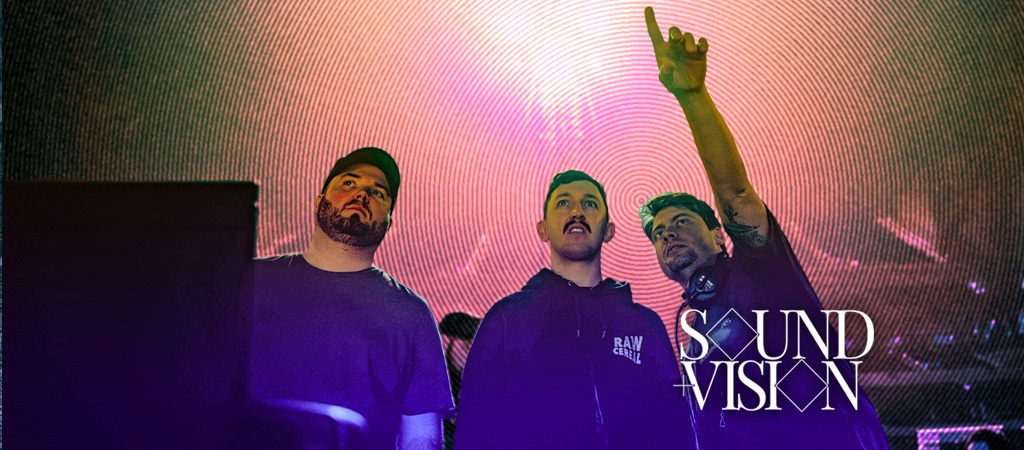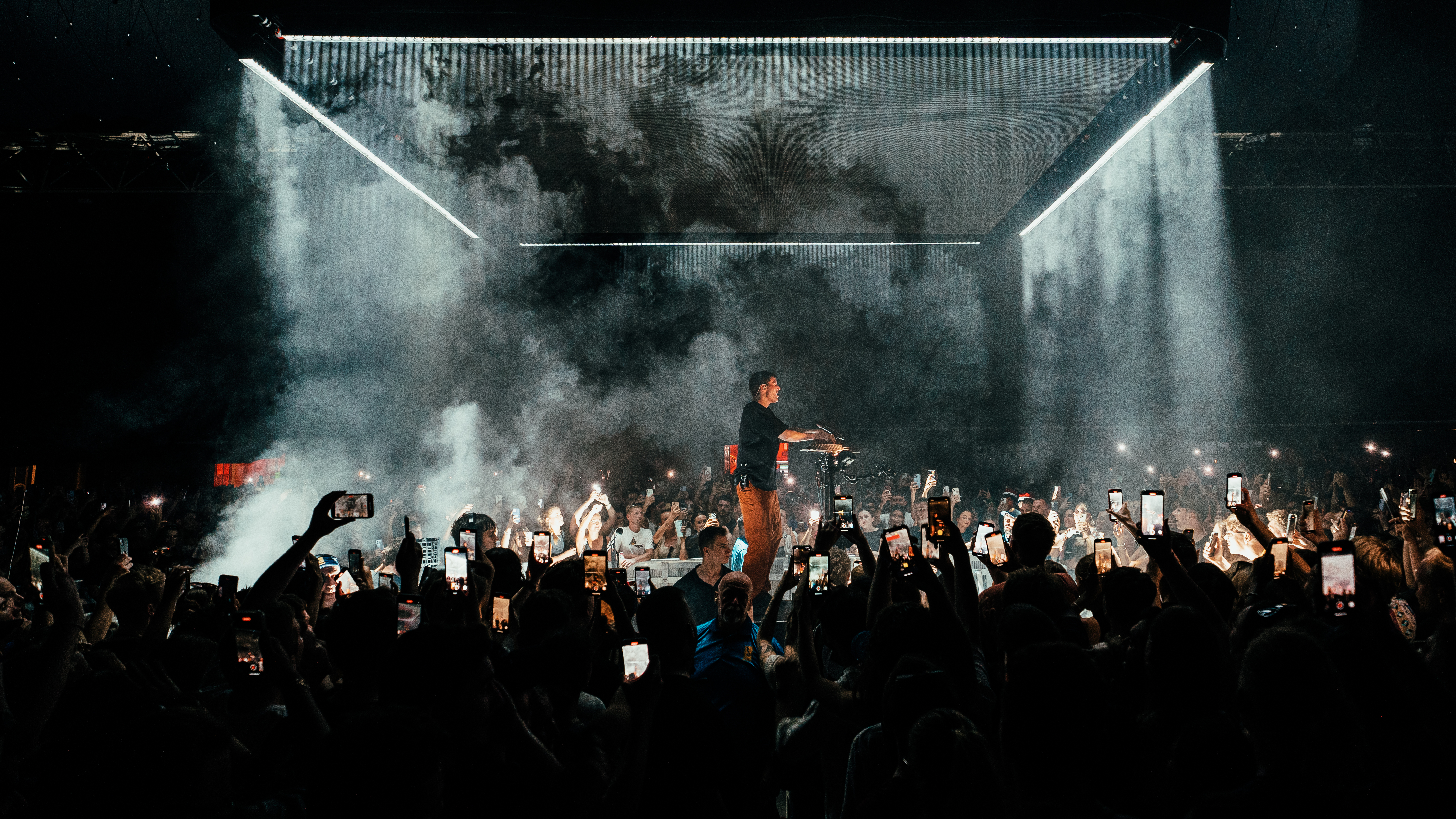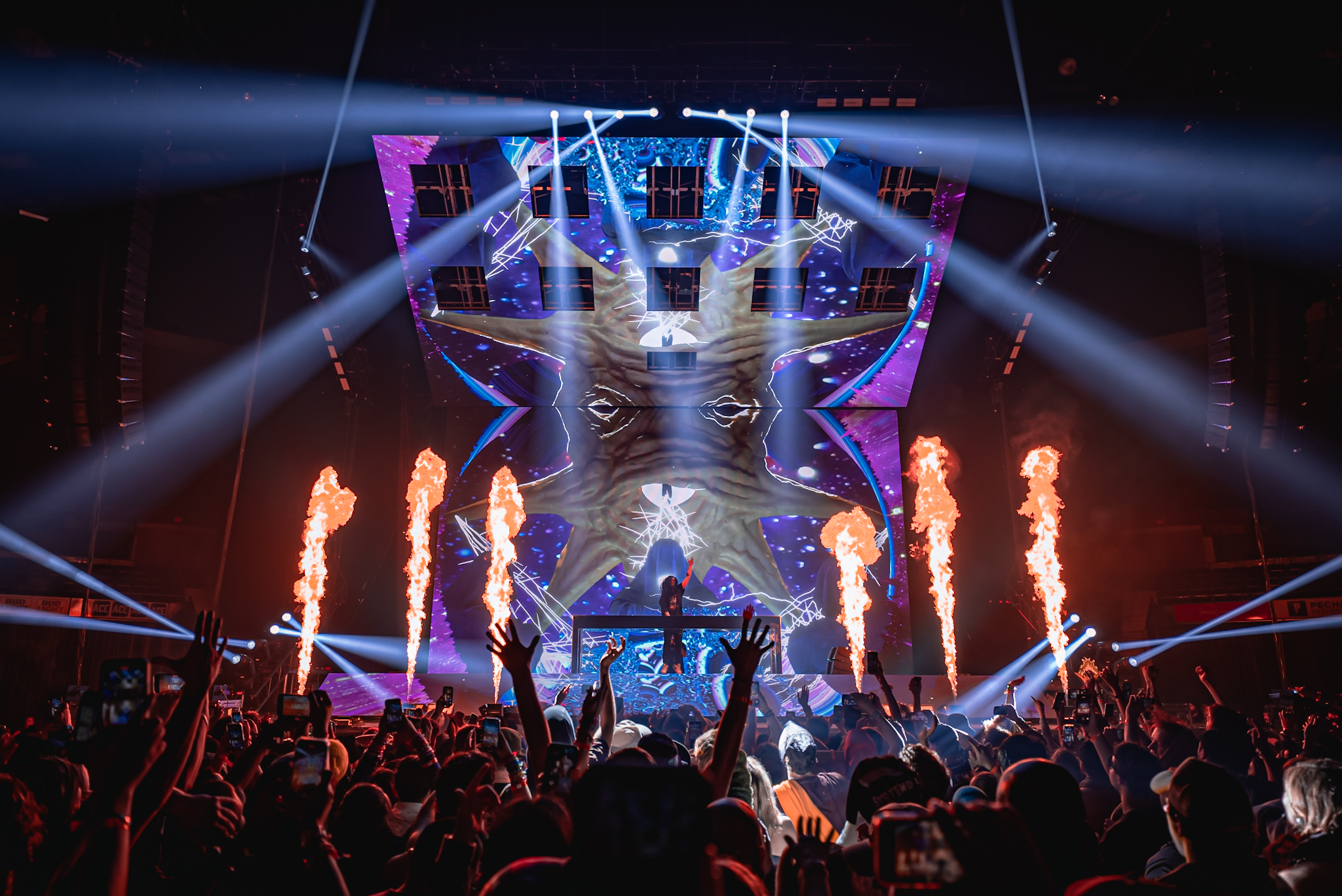
Anders Rahm fell in love with stage design and the aesthetics of live performance as a young kid. While others were saving up for PlayStations or basketball jerseys, Rahm, who co-founded creative design company Raw Cereal, was counting pennies in hopes of catching his favorite groups on tour.
“I used to say that my savings account was in a stack of concert tickets,” he explains to Uproxx with a chuckle.
Though his heart has always been in live music, Rahm took a circuitous path to where he is today: creating festival rigs and tour designs for artists like Fred Again.., Calvin Harris, Duke Dumont, and more. He went to college with hopes of being a chef, but by his mid-20s, he had abandoned that dream and got hired at a creative agency.
After years of hustling, he sent a “future resume” to Baz Halpin, who led design for Taylor Swift’s 1989 tour, among others, with his company Silent House. (Silent House’s work on Tyler The Creator’s 2023 Camp Flog Gnaw set just won the Sound + Vision award for Best Stage Show Design.) Halpin introduced Rahm to some of his collaborators, and he quickly found himself on set of his first gig as a freelance stage designer: Assisting the 2018 Super Bowl Halftime Show with Justin Timberlake.
When Rahm started Raw Cereal, he began following a simple tenet: He wanted his company’s work to represent “unprocessed creativity.” Now, as a go-to collaborator for EDM superstars across the globe, Rahm and Raw Cereal are expanding their scope as they continue to perfect the craft of making every concert an unforgettable, charged experience.

What were your introductions to the art and music worlds as a kid?
I just really loved music. My dad gave me a stack of records when I was 10 or 11, and it was right around the time that my parents had a guest room and we got our own rooms. My dad gave me the new room and he gave me a turntable receiver, two speakers, and some crates of records. I just really got into rock and roll, soul, and funk music. When I was a bit older, I started going to shows and festivals. I was just hooked on live music.
What did you go to school for?
I actually went to school to cook. I learned a lot from that, really. I still look at what we do today as a similar process. Running a kitchen is no different from running a creative services company. We’ve got specialized teams that focus on specialized things, and in order to run a good restaurant, it’s the same as running a solid operation.
I took an apprenticeship, which was really key for me. I realized that I learned from people as opposed to from classrooms. From there, I realized I could just find teachers and reach out to people I wanted to learn from. I found that more often than not, they were totally willing to support me in that. I started in my early 20s, and I left cooking and in my mid-20s.
I ended up at a creative agency, and through that creative agency, I met Baz Halpin. I was in Milwaukee at the time. He was in LA running Silent House. He had done Taylor Swift’s 1989 tour and led Katy Perry’s tour — all the biggest in the world. I had met him because he hired us to do some of his video edits.
Years later, I was living in Austin, and Baz was still reaching out to me pretty consistently for help with presentation. I thought to myself, “I love what he does and I really want to do what he does.” I reached out to him and gave him a future resume, where I wrote what I would like to have done and what I would like my job to be. He said, “I can help you with that.” He hooked me up with some of his partners and I moved to LA with the hopes of working with them.
They gave me a chance and as an intern, my first show with that group was the Super Bowl Halftime Show with Justin Timberlake [in 2018]. It kicked off pretty quickly that year. They allowed me to help project manage the graphics for Taylor Swift’s Reputation tour. I was a producer on Beyoncé’s On The Run tour and her Coachella show. From there, my freelance career was off, and then I continued on into starting Raw Cereal a few years ago.

What makes Raw Cereal different from any other company in your sphere?
Oftentimes, we say our internal note is, “We’re here to help.” We’re really a service-focused company, and I think our outward tagline is “unprocessed creativity.” There are a lot of folks really focused on telling stories. While we do tell some great stories, sometimes things get convoluted, and they get lost in the attempt to tell a story in an abstract space. A lot of times, we are able to help build a loose narrative that allows for more of a focused good time, as opposed to trying to follow along in a convoluted way. We’re trying to just convey emotion as opposed to direct attention.
How do you make sure things go off without a hitch when you’re working with someone like Calvin Harris on his Ibiza shows?
I go: That’s how we do it. We can’t always go if there’s overlap, but we have enough great people to where sometimes, we just say, ‘Hey, you’re going over here. I’m going over here.’ We try to be together as much as possible, but it doesn’t always work. With Calvin Harris specifically, I spent close to a month out there in Ibiza and onwards into some of his European festivals. We go to rehearsals, we have creative meetings prior, and then we try to be there as much as possible. I’m on a lot of planes. When we’ve got back-to-back shows, it is back-to-back travel. We like to be there. Hope doesn’t work in this industry. We’ve got to go there and make sure it goes well.
How did you begin shifting into the world of EDM?
We’ve been talking about working in EDM since forming Raw Cereal. Good work begets more work. When we do a good job, people end up calling us. Our work in EDM really started with HiJinx Music Festival. We’re the designers and production leads for HiJinx Music Festival, and we get a lot of connections through that. That was what kind of started it. We had so much fun doing that. We wanted to do more.
Eventually, Fred Again..’s team called and they’re like, “Hey, who can really make this happen and pull it together?” They had a huge ask with a very custom request. We become the fixers in certain scenarios, where people are struggling and they’re saying, “Well, we’ve got something really big on our hands. Who are the people that can come in and really do this, and who’s going to put in the time and effort to really figure it out?” As far as Calvin Harris is concerned, he saw our work and we sent him a deck and he said, “These guys have it. This is what I want.”
What’s the five-year plan for Raw Cereal?
We’re aiming for longer-term projects, specifically in the EDM space. We love dance music and we want to be involved further. That means venues, it means clubs, it means installations, it means international. I had built a club in Asia with XiteLabs at one point in my career, and I’d spent a fair amount of time looking at the Asian club scene. We’re working on some hospitality club design with some partners out of Europe, and then projects in the Middle East. We’re trying to branch out from the United States and branch out from touring shows, taking what we know and building new teams that can really put some longevity into the scene, and hopefully inspire generations of more shows. That’s a big focus for us. Concert touring and festival design installations in EDM, rock, pop, and hip-hop will always be a staple of ours: It’s what we’re built on. We’re just excited to take that into hospitality, venue, and brand design. We’re just looking outwards and upwards.
Does having a venue or a fixed location offer you more versatility?
It does and it doesn’t. What’s fun about the touring show is that you’ve got all kinds of one-off toys that you can play with. You’ve got trucks moving them around and bringing them in. With venue design, you’ve got to think a little bit longer-term. The builds are a little bit more difficult, and you also have to allow room for people to bring in production. While we potentially could go all out and just totally blow a space out of the water, we also have to think, “Well, when Fred comes, he’s going to need room for this, this, and this.” When we’re looking at venue space, we’re really thinking how we can align with consistent updates to design things more modular and accessible for artists that are coming in.
You never want to have an artist say they can’t play at your venue because there’s not space for their design.
That’s exactly it. It’s like moving into a furnished house when you’ve got all your stuff in the truck. What’s the point of buying all this if you can’t use it?
